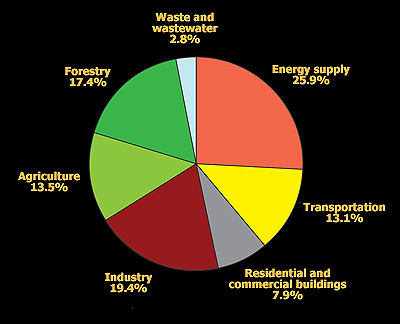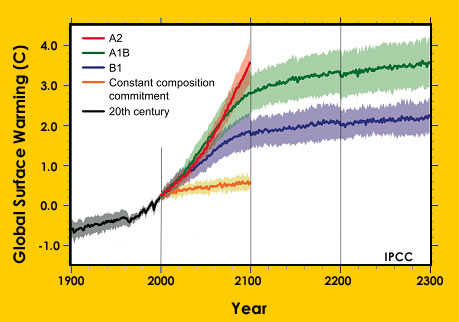Click on image for full size
IPCC Fourth Assessment Report, Working Group 3
Tackling the Global Warming Challenge
Earth’s climate is warming quickly and human activities are mostly to blame. By releasing greenhouse gases into the atmosphere, we have amplified Earth’s greenhouse effect, causing more global warming. Global warming impacts our planet in many ways from sea level rise to intense storms to the extinction of species.
In December 2007 a group of about 200 climate scientists signed a statement that said if we want to maintain a habitable planet we must take steps to reduce the amount of greenhouse gases we put into the atmosphere and slow the rate of global warming. They suggest that global greenhouse gas emissions need to be reduced by at least 50% below their 1990 levels by the year 2050. “There is no time to lose,” they wrote.
Reducing the amount of greenhouse gases that we release into the atmosphere each day is a good way to start. According to the 2007 report of the Intergovernmental Panel on Climate Change (IPCC) there are technologies available in many areas that can help, such as switching energy sources from coal to cleaner gas, nuclear power, or renewable energy. Driving only fuel-efficient vehicles and using public transportation limit the amount of greenhouse gases emitted too. And bicycling and walking are always good options. In buildings, having thick insulation and efficient appliances are good ideas.
Recently, many businesses, organizations, and governments have made it their goal to not add any additional carbon dioxide, a greenhouse gas, to the atmosphere. This is known as being “carbon neutral.”One way that groups are achieving their goal when they have to burn fossil fuels is by purchasing carbon offsets which support projects that build wind farms or plant trees, hopefully cancelling the effect of their fossil fuel use.
You can figure out how much carbon dioxide you personally are responsible for with an online carbon calculator. Knowing how much carbon dioxide you are sending into the atmosphere can help you set your own goal of how much you can reduce.
Thinking about the choices we make about how much energy we use and the types of energy we use is a good way to start considering how to reduce greenhouse gas emissions. Check out the Energy Choices and Climate Change online module to explore how our choices impact greenhouse gas emissions.
For almost two decades world leaders have been working together to reduce the amount of global warming caused by humans. Representatives from 192 countries signed a treaty in 1992 called the United Nations Framework Convention on Climate Change. A few years later they developed the Kyoto Protocol to reduce greenhouse gas emissions from industrialized countries. Now a new global climate treaty is being discussed to replace the Kyoto Protocol.
There are also promising technologies that are still in development which might help lessen global warming in the future. Scientists and engineers are working to develop more advanced renewable energy sources like wind turbines, solar power, and biodiesel fuels. New hybrid and electric cars are in development and so are airplanes that use less fuel. Scientists are also looking for ways to get carbon dioxide out of the atmosphere, technologies known as Carbon Storage and Capture.
Slowing global warming won’t happen overnight. It could take a couple of centuries to stabilize climate and even then there will be a lot of warming. However, according to the IPCC, by taking steps today, we could prevent some of the more catastrophic impacts of warming.















